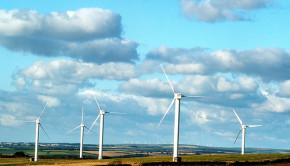Denmark Could Be Coal-Free In 11 Years
November 6th, 2014 by Jake Richardson
The coal industry must be horrified — an entire nation that wants to be coal-free by 2025? Imagine the press it will generate if Denmark can achieve this goal. The Climate and Energy Minister Rasmus Helveg Petersen said recently that Denmark is exploring how to quit burning coal for electricity, and fairly soon. Previously, the Denmark government had targeted 2030 as the time when it might be free of coal-based energy, but the time span has been shaved by five years.
“Of course, this is something we will do together with the industry. I don’t know how we can reach this goal, but I would like to find out if we, for example, can forbid using coal,” explained Petersen.
Currently, about 40% of Denmark’s energy supply is from oil and gas, with only 20% coming from coal. Wind power generates about 30%. Biogas, biomass, solar also contribute. The goal for wind power is to generate 50% of all electricity by 2020.
This looks like a real possibility, considering that Denmark has at times already generated more electricity than it consumed using wind power.
If just 20% of its electricity currently comes from coal and there are abundant wind power resources, the transition does seem very possible.
Burning coal produces toxic emissions, so the impetus to go coal-free is not only to fight climate changes. Human health is improved by reducing air pollution, so going coal-free is not only a “green” thing to do. Air pollution has been estimated to cause about 3,400 premature deaths a year in Denmark.
It is not radical in any way to want to improve air quality and at the same time fossil fuel emissions. Things will probably change very much in the next 11 years, in terms of energy production. How many electric vehicles will be on the roads around the world? Will there be other countries that are also close to kicking the coal habit?
Image Credit: De-Okin, Wiki Commons
Keep up to date with all the hottest cleantech news by subscribing to our (free) cleantech newsletter, or keep an eye on sector-specific news by getting our (also free) solar energy newsletter, electric vehicle newsletter, or wind energy newsletter.
-
Larmion
-
JamesWimberley
-
Larmion
-
-
-
No way
-
Hans
-
Jan Veselý
-
globi
-
tibi stibi
-
globi
-
Jan Veselý
-
Bob_Wallace
-
Larmion
-
Bob_Wallace
-
Larmion
-
Bob_Wallace
-
Larmion
-
Bob_Wallace
-
Larmion
-
-
No way
-
globi
-
-
JamesWimberley
-
Larmion
-
globi
-
-
Kevin McKinney
-
-
Hans
-
http://zacharyshahan.com/ Zachary Shahan
-
-
-



























